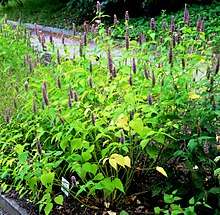Agastache foeniculum
| Agastache foeniculum | |
|---|---|
 | |
| Scientific classification | |
| Kingdom: | Plantae |
| (unranked): | Angiosperms |
| (unranked): | Eudicots |
| (unranked): | Asterids |
| Order: | Lamiales |
| Family: | Lamiaceae |
| Genus: | Agastache |
| Species: | A. foeniculum |
| Binomial name | |
| Agastache foeniculum | |
Agastache foeniculum (blue giant hyssop; syn. Agastache anethiodora (Nutt.) Britton), commonly called anise hyssop, blue giant hyssop, Fragrant giant hyssop, or the lavender giant hyssop, is a species of perennial plant in the mint family, (Lamiaceae). This plant is native to much of north-central and northern North America, notably the Great Plains and other prairies, and can be found in areas of Canada.[1][2] It is tolerant of deer and drought, and also attracts hummingbirds and butterflies making it an attractive selection for gardeners.[3]
Anise hyssop is in the same family as hyssop (the mint family Lamiaceae), but they are not closely related. Hyssop (Hyssopus) is a genus of about 10-12 species of herbaceous or semi-woody plants native from the east Mediterranean to central Asia.[1]
Description
This species grows from 2 ft (61 cm) to 4 ft (120 cm) tall and 1 ft (30 cm) wide, in a clump-like, upright shape, with flowers appearing in showy verticillasters, or false whorls, and occasionally branching at the apex.[4] The leaves have an oval, toothed shape with a white tint underneath. The plant blooms in June to September with bright lavender flowers that become more colorful near the tip.[3][5] The root system produces a taproot.[4]
Uses
Anise hyssop was used medicinally by Native Americans for cough, fevers, wounds, diarrhea. The soft, anise-scented leaves[5] are used as a seasoning, as a tea, in potpourri, and can be crumbled in salad. The purple flower spike is favored by bees who make a light fragrant honey from the nectar.[6]
References
- 1 2 3 "Agastache foeniculum". Natural Resources Conservation Service PLANTS Database. USDA.
- ↑ "Agastache foeniculum". County-level distribution map from the North American Plant Atlas (NAPA). Biota of North America Program (BONAP). 2014.
- 1 2 "Agastache foeniculum". Missouri Botanical Gardens. Retrieved 20 December 2013.
- 1 2 Hilty, John (2016). "Anise hyssop". Illinois Wildflowers. Retrieved 20 December 2013.
- 1 2 "Agastache foeniculum (Anise hyssop)". Fine Gardening. Retrieved 20 December 2013.
- ↑ "Herbs"; Smithsonian Handbook - Lesley Bremness